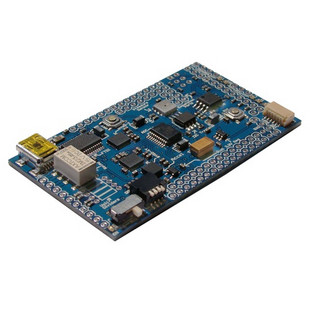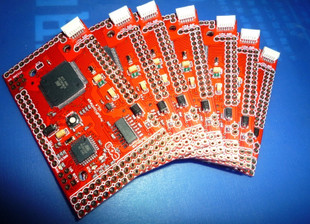
China copy Ardupilot mega - ½ price!
Robert Krogh (hooks)
May 18, 2011
Made in China!
Don't know what to say.


Ardupilot
mega IMU: 520 rmb = 80 USD [ http://item.taobao.com/item.htm?id=9130085673&frm=
]

Ardupilot mega 240.00 rmb = 36 USD [ http://item.taobao.com/item.htm?id=9075789929&frm= ]
I found Ardupilot Mega + IMU board on (taobao)
I have no idea about quality, sensor or anything else.
Any comments?
1:29pm
Chris Anderson
May 18, 2011
Our products are open source, so this is allowed. However they may not use the
name ("ArduPilot Mega") or our logo, which are trademarked. So we'll be filing to
make them change the name.
Needless to say, if you buy these boards, you
can't get support from us and who knows what the quality is. So caveat emptor!
1:45pm
Matthias Badaire
May 18, 2011
Chris,
Can you tell us what does it mean for this community if you get less money from us ? ie: are the core dev paid/supported by diydrones sales ? is it paying for the forums website ?
I just want to understand why it may not be a good thing for the long term to go chinese and to counter-balance the short term benefits.
2:09pm
Chris Anderson
May 18, 2011
It's pretty simple. 3D Robotics is a hardware development business. The more successful we are as a business, the more hardware designers we can hire to create new products, and the more production equipment we can buy to make them, the more customer support we can provide etc. We're 100% focused on creating great products for this community. If we grow, it's because we've given our customers what they want.
DIY Drones, meanwhile, is a community. It is built by you all and exists to serve your needs. It's free and always will be. This community not only provides information and support for each other, but also includes the many dozens of people who make up the development teams that create the software that gives the 3D Robotics hardware all of its value. The most important work is done by volunteers here and given freely to all.
This is the classic open source hardware model. Software, which costs nothing to distribute, is free. Hardware, which is expensive to make, is priced at the minimum necessary to ensure the healthy growth of a sustainable business to ensure quality, support and availability of the products. All intellectual property is given away, so the community can use it, improve it, make their own variants, etc.
The possibility that others would clone the products is built into the model. It's specifically allowed by our open source licence. Ideally, people would change/improve the products ("derivative designs") to address market needs that they perceive and we have not addressed. That's the sort of innovation that open source is designed to promote. But if they only clone the products and sell them at lower prices, that's okay, too. The marketplace will decide.
Either way, the DIY Drones community will be unaffected. It is not a business, but rather a free service by and for the members (the small hosting costs are paid for by Google AdSense ads).
BTW, Arduino has gone through exactly the same situation, with many Chinese cloners. The clones were sometimes of lower quality, but even when they were good most people continued to support the official Arduino products and the developers that created them. Today, clones have a small share of the market, mostly in very price sensitive markets such as China. And frankly, being able to reach a lower-price market is a form of innovation, too, and that is no bad thing.
Personally, I'm delighted to see this development, for four reasons.
3:15pm
brakar
May 18, 2011
This might describe the dilemma of combining the ideas of making open source hardware - and making profit out of selling the hardware at the same time. There will allways be an upper limit to the profit levels/amount of success before competitors will appear. So, time for releasing the next new and improved hw - and maybe go closed?
3:22pm
Chris Anderson
May 18, 2011
brakar: We will never go closed source. We not only have an unshakable belief in the ultimate superiority of the open source model in accelerating innovation, but the work is the collective property of this community. It was created under a promise of openness and accessibility to all, and it is my job to preserve that at all costs.
If that means there is an upper limit to the profit we or any other open source hardware company can make, so be it. Profit is not the main driver of any open source hardware company (Sparkfun, Adafruit, Makerbot, etc); we're all much more driven by the opportunity to change the world for the better in our own little way. (Yes, you have to be a bit of a starry-eyed idealist to run an open source effort. But there's no shortage of evidence that it works.)
3:37pm
mquintilian
May 18, 2011
Maybe I'll purchase one for "testing" purpose's. This is certainly better than them modifying the design and use a closed source license. I't would be interesting to see what kind of mark-up is on DIY Drones products.
3:41pm
Chris Anderson
May 18, 2011
Mquintilian: I've written many times about our business model. This [ http://diydrones.com/profiles/blogs/the-diy-drones-open-source ] is the main post, but you can read more here [ http://www.diydrones.com/profiles/blogs/does-open-source-undermine ].
The short form is that it's based on the standard Open Hardware model of 2.6x the BOM cost. That allows one 40% margin for us and one 40% margin for our retail partners. It's enough margin to allow for labor and other overheads (rent, insurance, taxes), returns, defects, customer support and continued investment in new manufacturing equipment.
We're pretty transparent about these things, and I share most of it here on the site, not just for the customers but also to provide advice and best practice to help other Open Hardware companies get started.
3:55pm
Copyright 2011 http://diydrones.com/